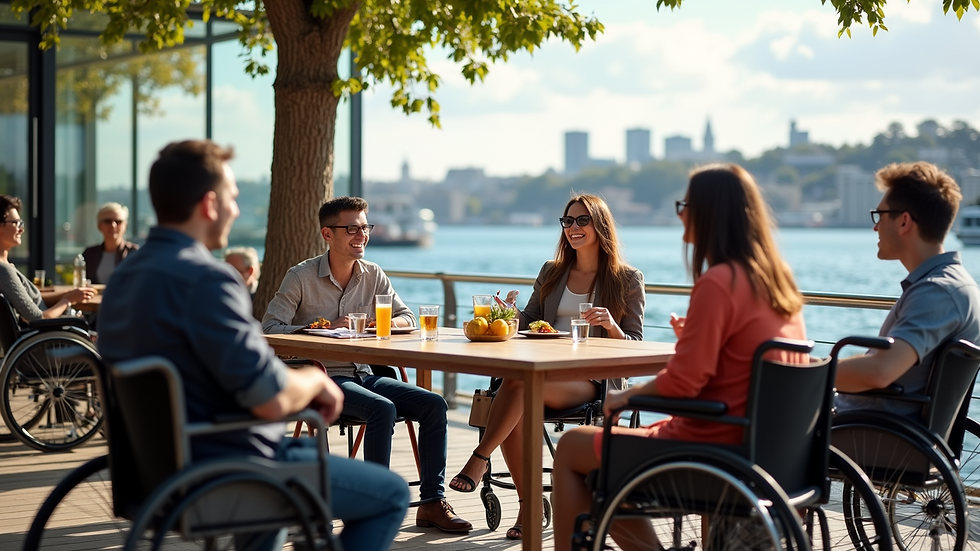Empowering Disabled Australians Through Advocacy
- Jonathan Shar

- Oct 10
- 4 min read
The landscape of disability rights in Australia has evolved significantly over recent decades, yet the journey toward full inclusion and empowerment remains ongoing. People with disabilities are not merely recipients of welfare or participants in government schemes; they are innovators, contributors, and agents of change within society. When barriers and discrimination arise, the disability community consistently responds with innovation aimed at fostering inclusion and dismantling limiting stereotypes. This article explores the mechanisms of advocacy, the role of key organisations, and practical steps toward empowering disabled Australians.
Understanding Disability Rights in Australia
Disability rights in Australia are grounded in principles of equality, dignity, and accessibility. These rights are enshrined in legislation such as the Disability Discrimination Act 1992 (DDA), which prohibits discrimination on the basis of disability in various areas including employment, education, and access to services. Additionally, the National Disability Strategy 2010-2020 outlines a framework for improving the lives of people with disabilities through inclusive policies and community engagement.
Despite these frameworks, challenges persist. Physical barriers, attitudinal biases, and systemic exclusion continue to limit opportunities for many. Advocacy plays a crucial role in addressing these issues by raising awareness, influencing policy, and supporting individuals to assert their rights. Advocacy efforts often focus on:
Promoting accessibility in public spaces and digital platforms.
Ensuring equitable employment opportunities.
Enhancing educational inclusion.
Supporting independent living and community participation.
Empowerment through advocacy means equipping individuals with the knowledge and tools to navigate systems, challenge discrimination, and contribute meaningfully to society.

The Role of Advocacy Organisations in Shaping Policy
Advocacy organisations serve as vital intermediaries between individuals with disabilities and policymakers. They collect data, represent community voices, and propose legislative reforms. Australian Disability Ltd, for example, is committed to creating a fairer society by raising awareness through media, fostering community connections, and advocating for disability rights.
These organisations often engage in:
Policy consultation and development: Providing expert advice to government bodies.
Community education: Offering workshops and resources to inform people about their rights.
Legal support: Assisting individuals in cases of discrimination or rights violations.
Campaigning: Mobilising public support for disability-inclusive initiatives.
By collaborating with stakeholders across sectors, advocacy groups help to ensure that disability rights are integrated into broader social and economic policies.

What's the difference between NDS and NDIS?
Understanding the distinction between the National Disability Services (NDS) and the National Disability Insurance Scheme (NDIS) is essential for navigating the disability sector in Australia.
National Disability Services (NDS) is the peak body representing non-government disability service providers. It focuses on supporting organisations that deliver services to people with disabilities, advocating for quality service provision, workforce development, and sector sustainability.
National Disability Insurance Scheme (NDIS) is a government-funded program that provides individualised support packages to people with disabilities. It aims to enhance independence and social participation by funding reasonable and necessary supports tailored to each participant’s needs.
While NDS advocates for service providers and systemic improvements, the NDIS directly impacts individuals by offering personalised funding and support plans. Both entities play complementary roles in advancing disability rights and inclusion.
Practical Steps to Empower Yourself and Others
Empowerment is not solely the responsibility of organisations or governments; individuals and communities can take proactive steps to foster inclusion and advocate for rights. Here are some actionable recommendations:
Educate Yourself and Others
Understanding your rights and the available supports is fundamental. Resources from reputable organisations, including disabled australia, provide valuable information on legal protections, services, and advocacy opportunities.
Engage in Community Networks
Joining local disability groups or online forums can provide social support, share experiences, and amplify collective voices. Community engagement also facilitates peer learning and collaboration on advocacy initiatives.
Participate in Policy Consultations
Governments and organisations often seek input from people with disabilities when developing policies. Taking part in surveys, forums, or public consultations ensures that your perspective influences decision-making.
Challenge Discrimination
When encountering barriers or unfair treatment, consider formal complaint mechanisms or seek advice from advocacy services. Documenting incidents and understanding complaint procedures can lead to systemic change.
Promote Inclusive Practices
Whether in workplaces, schools, or social settings, advocating for accessibility and inclusive attitudes helps break down stereotypes and fosters environments where everyone can thrive.

Moving Forward: Building a More Inclusive Australia
The path toward a more inclusive Australia requires sustained commitment from all sectors of society. Advocacy remains a powerful tool to ensure that people with disabilities are recognised not only for their challenges but for their contributions and potential. By supporting advocacy efforts, engaging in community dialogue, and promoting inclusive policies, a fairer society can be realised.
Australian Disability Ltd’s mission to empower individuals and shift public perception is a critical component of this progress. Through media campaigns, community building, and policy advocacy, the organisation helps to dismantle barriers and create opportunities for meaningful participation.
Ultimately, the goal is to foster a society where disability is understood as a natural aspect of human diversity, and where every individual has the opportunity to innovate, lead, and contribute without limitation.
Empowerment through advocacy is a continuous process that benefits from your active involvement and awareness. By embracing the principles of inclusion and equity, the vision of a fairer Australia for people with disabilities can become a reality.











Comments